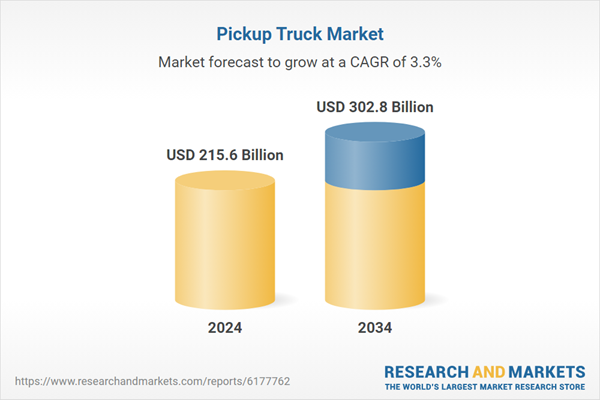As a critical segment within the global automotive industry, pickup trucks continue to gain traction across personal, commercial, industrial, and recreational applications. Consumers are increasingly drawn to trucks that blend utility and everyday usability, offering space, ruggedness, and comfort in one package. The segment is evolving with rising interest in electric and hybrid-powered options, which are gaining momentum not just because of environmental regulations but also due to innovation and growing buyer interest. Automakers are integrating high-end comfort, infotainment, and advanced safety systems while maintaining strong towing and payload capabilities, making pickups appealing to both families and fleet owners.
The industry has seen a major shift toward electric mobility, with manufacturers channeling investments into EV technology to address environmental goals and future regulatory requirements. In response to industry-wide disruptions, many companies also established collaborative alliances to reduce development expenses and streamline supply chains. These partnerships resulted in the integration of connected tech, electrification, and versatile design features, driving customer engagement and adapting to the fast-changing auto landscape.
In 2024, the personal-use category held 61% share and will grow at a CAGR of 3% through 2034. This leadership is driven by rising demand for multipurpose vehicles that can handle commuting, family travel, and outdoor lifestyles with ease. Buyers are looking for performance-driven trucks that don’t sacrifice convenience, leading manufacturers to introduce luxury-grade interiors, touchscreen controls, smart safety features, and top-tier infotainment in their higher-end variants. These evolving preferences are reshaping the image of pickup trucks from utilitarian machines to well-rounded, daily-use lifestyle vehicles.
The full-size pickup segment held a 55% share in 2024 and is forecasted to grow at a CAGR of 2.6% between 2025 and 2034. Full-size pickups are widely preferred for their strength, space, and towing capabilities. Manufacturers are upgrading these models with EV drivetrains and exclusive trims offering customized features, expanded range, and sophisticated performance packages. The appeal of luxury trims in full-size pickups has elevated customer expectations, pushing OEMs to develop comprehensive ownership experiences with added convenience, loyalty perks, and digital-first service solutions.
U.S. Pickup Truck Market held 90% share and generated USD 99.8 billion in 2024. The segment remains the country’s best-selling vehicle category, due to a widespread cultural and functional preference for full-size trucks. Personal and recreational usage has grown significantly, and consumer appetite for high-spec, electrified models continues to surge. Automakers are launching advanced variants and tech-rich trims to retain loyalty while attracting new audiences.
Major companies actively competing in the Global Pickup Truck Market include Nissan, Stellantis (Ram Trucks), Ford, Alpha Motor, Toyota, Honda, Chevrolet, GMC, Bollinger, and Canoo. To maintain and strengthen their positions in the competitive pickup truck market, leading manufacturers are pursuing multiple strategic initiatives. They are heavily investing in electrified vehicle platforms and battery technology to align with environmental regulations and customer expectations for sustainable mobility. Simultaneously, companies are expanding product lines with luxury-oriented and performance-driven trims tailored for specific customer lifestyles. Strategic alliances and joint ventures are playing a role in accelerating product development, optimizing production, and enhancing supply chain resilience. Additionally, many players are building direct-to-consumer digital retail platforms and enhancing aftersales service offerings to improve customer loyalty and long-term engagement.
Comprehensive Market Analysis and Forecast
- Industry trends, key growth drivers, challenges, future opportunities, and regulatory landscape
- Competitive landscape with Porter’s Five Forces and PESTEL analysis
- Market size, segmentation, and regional forecasts
- In-depth company profiles, business strategies, financial insights, and SWOT analysis
This product will be delivered within 2-4 business days.
Table of Contents
Companies Mentioned
The companies profiled in this Pickup Truck market report include:- Ford
- GMC
- Stellantis (Ram Trucks)
- Toyota
- Nissan
- Honda
- Rivian Automotive
- Tesla
- Isuzu Motors
- Mahindra & Mahindra
- Chevrolet
- Great Wall Motors
- Canoo
- Alpha Motor
- Bollinger
- SAIC Motor
- Tata Motors
- Volkswagen Commercial Vehicles
- Mitsubishi Motors
- Hyundai Motor Company
- JAC Motors
- Foton Motor
- SsangYong Motor
- Changan Automobile
- Lordstown Motors
- Atlis Motor Vehicles
- Fisker
- Hercules Electric Vehicles
- Nikola
- Workhorse
- XOS
Table Information
| Report Attribute | Details |
|---|---|
| No. of Pages | 225 |
| Published | September 2025 |
| Forecast Period | 2024 - 2034 |
| Estimated Market Value ( USD | $ 215.6 Billion |
| Forecasted Market Value ( USD | $ 302.8 Billion |
| Compound Annual Growth Rate | 3.3% |
| Regions Covered | Global |
| No. of Companies Mentioned | 32 |









